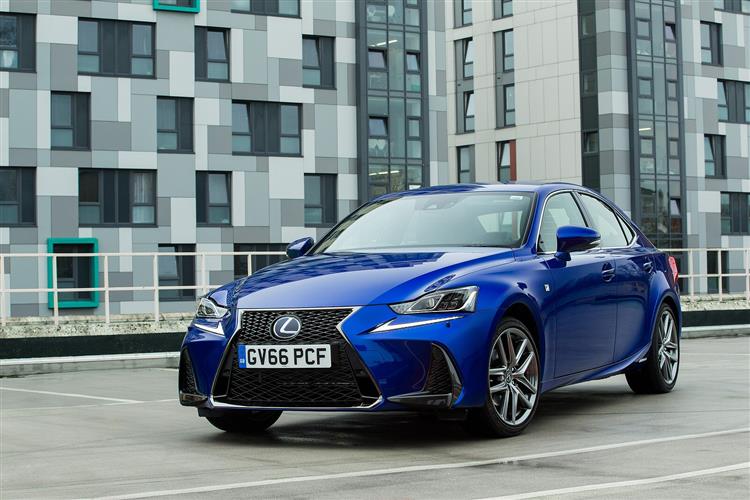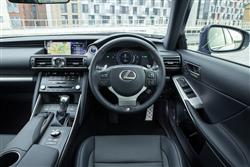I FOR ELECTRIC (some text hidden) --NONE--
By Jonathan Crouch
Introductionword count: 74
'Hybrid power', said Lexus IS Chief Engineer Naoki Kobayashi at the launch of the third generation Lexus IS in 2013, 'is both the personality and the biggest strength of our brand'. Proof of that was delivered with the IS 300h, a car that offered independent-thinking buyers in the compact executive saloon sector in this century's second decade a real alternative to the kind of four cylinder diesel engine that most would otherwise have chosen.
Modelsword count: 8
Saloon - IS 300h - 2.5 petrol/electric hybrid
Historyword count: 169
Buying a compact executive saloon from the 21st century's second decade, something like a BMW 3 Series, an Audi A4 or a Mercedes C-Class? Then you're probably buying a diesel. Should you be? Lexus has always thought not. For the same kind of money, their MK3 model IS300h petrol/electric hybrid always offered a quieter, cleaner, more economic and better equipped alternative. Best of all perhaps, it's different. For some, that'll be reason enough to try it. Most though, will need a bit more convincing. In which case, the efficient returns - quoted in period as a combined cycle 65.7mpg figure and 99g/km of CO2 - should get your attention. If that's piqued your interest, then a glance at the car itself should keep it. So is it a model you should add to your wish list? Let's find out. The MK3 IS 300h was usefully updated in 2017, but when production finished in 2021, this model line wasn't replaced, Lexus directing customers instead to the slightly larger ES saloon.
What You Getword count: 464
Lexus switched decisively from bland to bold with this MK3 model IS and the post-2017-era revised version adopted an even more assertive persona. It's difficult to believe that when work first started on this third generation design back in 2008, the original plan was for it to be a badge-engineered Toyota Avensis. Thankfully, common sense prevailed and what we ended up with is a properly credible alternative to the established premium players in this segment. As with the earlier version of this MK3 IS model, the saloon body style was all that Lexus was prepared to offer. And inside? Well with most rivals in this segment from this period, original buyers had to spend quite a lot to get a really luxurious-feeling cabin but in this IS, there was a premium feel to the interior right across the range. The mid-term facelift update changes made here were as subtle as the outside ones, with perhaps the most significant alteration being a slight reduction in the width of the console provided for the audio and ventilation controls. That allowed the driver and passenger knee pad panels to run right up into the centre stack where twin vents got separated by a lovely analogue clock. Above that sits the obligatory infotainment screen, this the 7-inch monitor provided with the 'Lexus Media Display' fitted to most IS models. This isn't the touchscreen set-up you'll find in most rivals, but it works quote effectively via a rotary dial near the gearstick that lets you click through the usual audio, telephone, navigation and car-related segments, plus there's a section that adds further climate control features. Go for one of the really plush variants and you may get yourself a version of this car fitted with Lexus's larger 10.3-inch screen, provided as part of the 'Lexus Premium Navigation' system. With this though, you have to have what Lexus calls a 'Remote Touch Interface controller', essentially an eight-way moveable 'mouse' that works a screen cursor requiring quite a subtle touch. Overall, we prefer the functionality of the lesser set-up. And in the back? Well the lengthened wheelbase of the MK3 IS model always offered much more rear space than the old pre-2013 second generation design could provide, but it's still fairly compact in the rear, though that's also the case with most obvious rivals. There's really only space for two in the back, something guaranteed by the extremely prominent transmission tunnel. As for the boot, well the fact that batteries must be housed beneath the floor of the hybrid IS 300h model robs this trunk area of 30-litres of space. Need more space? Well, unlike rivals, there's no estate body style option but if you've avoided entry-level trim, there is the option of being able to push forward the rear seatbacks.
To see the full road test text contact us on 0330 0020 227
Pictures (high res disabled)

.jpg)
|
.jpg)
|
.jpg)
| |||
.jpg)
|
.jpg)
|
.jpg)
| |||

|
Scoring (subset of scores)
Category: Luxury Saloons and Estates
| Performance | |
| Handling | |
| Comfort | |
| Space | |
| Styling, Build, Value, Equipment, Depreciation, Handling, Insurance and Total scores are available with our full data feed. | |



